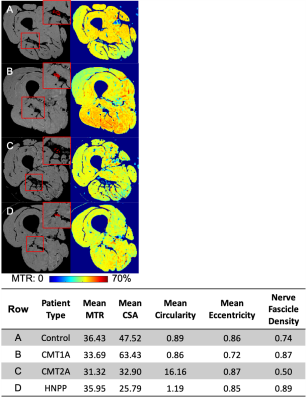Alison R Roth1, Jun Li2, and Richard Dortch1
1Neuroimaging Research, Barrow Neurological Institute, Phoenix, AZ, United States, 2Neurology, Wayne State University, Detroit, MI, United States
1Neuroimaging Research, Barrow Neurological Institute, Phoenix, AZ, United States, 2Neurology, Wayne State University, Detroit, MI, United States
Magnetization transfer ratio (MTR) from the sciatic nerve were found to be the most promising potential imaging biomarkers in patients with inherited neuropathies. Cross-sectional area, circularity, eccentricity, and nerve fascicle density also showed potential.

Figure 2: Box and whisker plots with data points of MTR (magnetization transfer ratio), CSA (cross-sectional area), circularity, eccentricity, and nerve fascicle density by subject type. CMT1A is Charcot-Marie-Tooth Type 1A, CMT2A is CMT type 2A, and HNPP is hereditary neuropathy with liability to pressure palsy.

Figure 1 Left: Representative magnetization transfer (MT)-weighted MRI images of study subjects with segmented sciatic nerves in red in magnified inlay. Right: Magnetization Transfer Ratio (MTR) for subjects. Subjects in row A are healthy controls, B have Charcot-Marie-Tooth type 1A, C have CMT type 2A, and D have hereditary neuropathy with liability to pressure palsy (HNPP). Patient imaging values are shown in the table.
